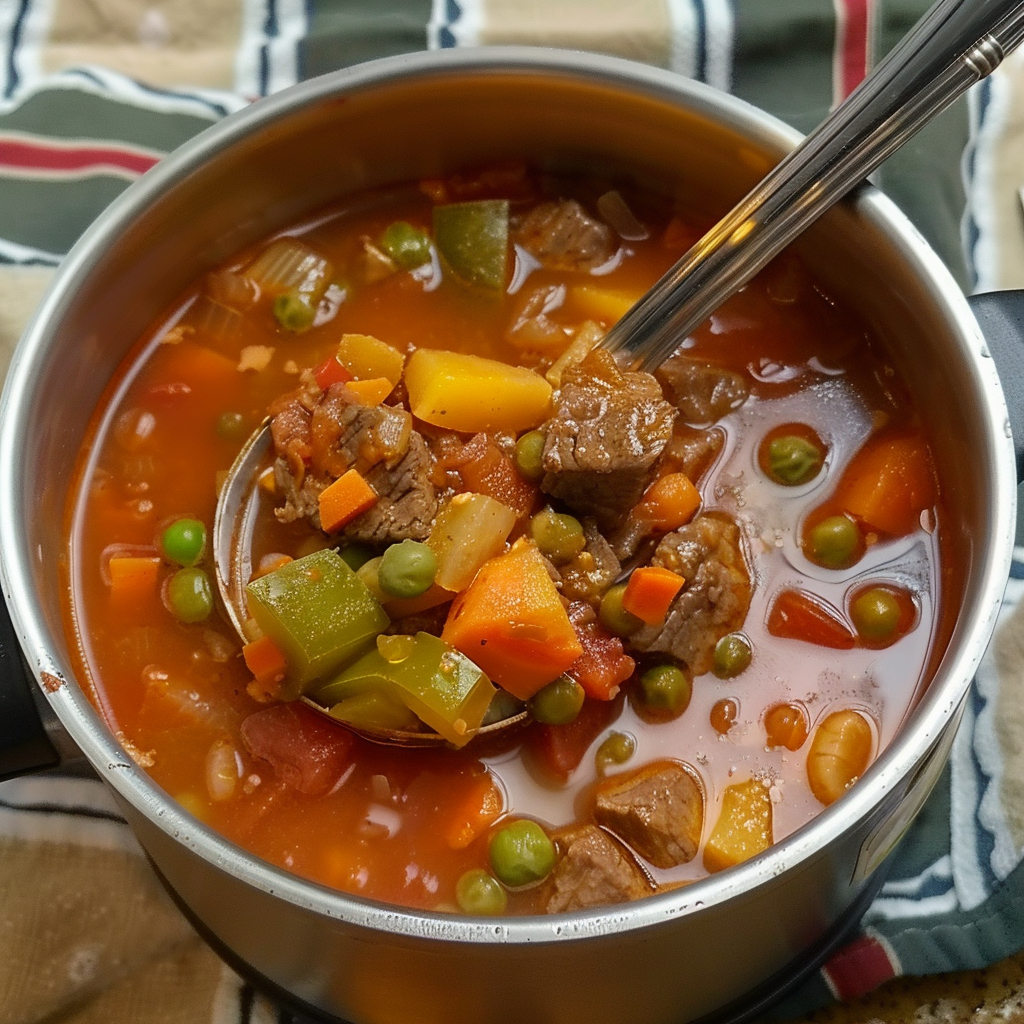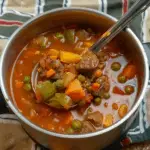1.Easy Vegetable Beef Soup
When it comes to comfort food classics, few dishes satisfy like a warm bowl of vegetable beef soup. This timeless recipe blends tender beef, vibrant vegetables, and rich broth to create a hearty meal that’s not only nourishing but incredibly flexible. Whether you’re cooking with fresh produce from your garden or cleaning out the freezer, this soup adapts effortlessly to whatever you have on hand.
Perfect for busy weeknights or slow Sundays, easy vegetable beef soup offers a filling, budget-friendly solution the whole family will enjoy. Its universal appeal lies in its simplicity—brown your meat, toss in your veggies, and let everything simmer to perfection. If you’re new to homemade soup recipes, this is a great place to start.
Beyond its ease, this dish also provides numerous health benefits. Packed with fiber, protein, and essential vitamins, it supports a balanced diet. For those who like to prepare meals ahead of time, this soup freezes exceptionally well. It’s ideal for meal prep or batch cooking, saving you time without sacrificing flavor. For even more meal inspiration, check out these vegetable soup ideas on Pinterest or explore the nutritional benefits of carrots used in soups.
If you’re craving a hearty bowl that comes together in under an hour and welcomes endless customizations, look no further. This essential beef vegetable soup recipe will quickly become a staple in your home kitchen.
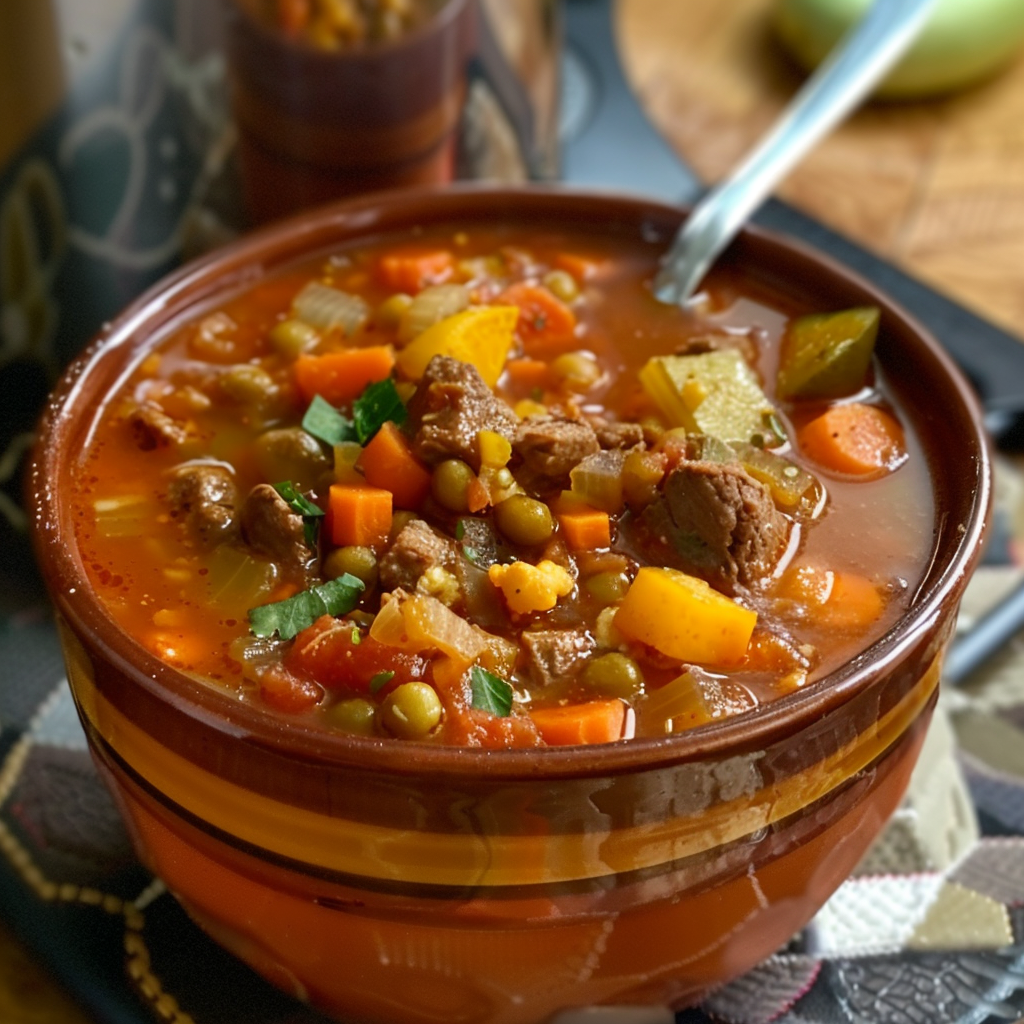
2. Why You’ll Love This Ground Beef Vegetable Soup
There are countless reasons why ground beef vegetable soup deserves a spot in your weekly meal rotation. It strikes the perfect balance between convenience, nutrition, and flavor — all while being incredibly affordable.
-
Quick and Easy: This soup is perfect when you need dinner on the table fast. You can have it ready in under an hour, thanks to the use of ground beef, which cooks much faster than traditional stew meat.
-
Pantry-Friendly: It works just as well with frozen vegetables as it does with fresh ones. You can use canned tomatoes, frozen green beans, and potatoes that have been sitting in your pantry.
-
Customizable to Your Taste: Whether you’re going for a low-carb version or want to throw in extra grains like barley or rice, this soup adapts beautifully. For a twist, you can even check out low carb soup ideas on Pinterest.
-
Meal Prep Friendly: This soup stores well in the fridge and freezes like a dream. Double the recipe and enjoy hearty, homemade meals all week long.
It’s no surprise that comfort food soups like this are trending for fall and winter. Visit this Pinterest board of comfort food soup ideas to discover more cozy inspirations. Whether you’re a busy parent, a beginner cook, or simply craving something warm and filling, this recipe delivers on every front.
3. Ingredients Breakdown & Substitutions
Making a delicious vegetable beef soup starts with the right ingredients—but one of the best things about this recipe is how flexible it can be. Here’s a detailed breakdown of each component, along with smart substitutions to match your taste, dietary needs, or what’s already in your kitchen.
Protein Options
-
Ground Beef: Classic, quick-cooking, and budget-friendly. Choose lean beef (like 90/10) to reduce grease without sacrificing flavor.
-
Stew Meat or Chuck Roast: These cuts add depth and richness but require longer cooking times to become tender.
-
Alternatives:
-
Ground turkey or chicken for a leaner option.
-
Plant-based meat crumbles for a vegetarian or vegan twist.
-
For more on meat variations, explore this Wikipedia guide to beef, which details different cuts and uses.
Vegetable Choices
-
Classic Mix:
-
Carrots
-
Celery
-
Potatoes
-
Green beans
-
Zucchini
-
Diced tomatoes (canned or fresh)
-
-
Fresh vs. Frozen:
-
Frozen veggies cut down on prep time.
-
Fresh vegetables offer a firmer texture and fresher taste.
-
-
Substitution Ideas:
-
Use corn, peas, or bell peppers.
-
Add seasonal vegetables like butternut squash or spinach.
-
Learn more about key vegetables like zucchini and how it complements soups.
Broth and Seasonings
-
Beef Broth: Adds a rich, savory base. Use homemade for deeper flavor or opt for low-sodium store-bought versions to control salt content.
-
Alternatives:
-
Vegetable broth for a lighter or vegetarian version.
-
Chicken broth if that’s what you have on hand.
-
-
Herbs and Spices:
-
Dried thyme and basil are go-to choices.
-
Add a bay leaf, paprika, or a splash of Worcestershire sauce for enhanced depth.
-
Season in layers for the best flavor.
-
For more healthy cooking fats, learn about the benefits of olive oil, which is ideal for sautéing the base aromatics.
Budget-Friendly Swaps
-
Use bulk frozen mixed veggies instead of buying each fresh.
-
Replace beef with lentils or beans for a protein-packed vegetarian version.
-
Buy meat in bulk and freeze for future use.
Need more ideas for affordable dishes like this one? Explore these easy ground beef recipes on Pinterest for inspiration. Whether you stick to the original or try a variation, this hearty beef soup adapts to your pantry, budget, and schedule.
4. Step-by-Step Instructions with Pro Tips
Cooking vegetable beef soup is as simple as it is satisfying. Whether you’re using ground beef or stew meat, the process remains straightforward and yields a delicious, hearty soup every time. Follow these step-by-step instructions to master this essential recipe and elevate your soup-making game.
Step 1: Brown the Beef
-
In a large pot or Dutch oven, heat 1 tablespoon of olive oil over medium-high heat.
-
Add 1 lb of ground beef (or beef stew meat, if using).
-
Brown the meat thoroughly until it’s no longer pink, breaking it apart with a wooden spoon as it cooks.
-
For stew meat, sear until browned on all sides but not fully cooked through—this will happen during simmering.
-
Remove beef from the pot and set it aside.
Pro Tip: Browning the meat first develops a deep, savory flavor that forms the foundation of your broth. Learn more about why browning is essential in soup preparation.
Step 2: Sauté Aromatics
-
In the same pot, add 1 chopped onion and 2 cloves of minced garlic.
-
Sauté for 2–3 minutes, or until fragrant and translucent.
-
Use a wooden spoon to scrape up any brown bits stuck to the bottom—these add flavor.
Step 3: Add Hardy Vegetables
-
Stir in:
-
3 sliced carrots
-
3 sliced celery stalks
-
2 diced potatoes
-
-
Cook for 5–6 minutes, stirring occasionally, to begin softening the vegetables.
These vegetables are the heart of a traditional beef vegetable soup. Discover how ingredients like carrots contribute both texture and nutrients to the dish.
Step 4: Return Beef and Add Broth
-
Add the browned beef back into the pot.
-
Pour in:
-
4 cups of beef broth
-
1 can (14.5 oz) diced tomatoes with their juices
-
-
Season with:
-
1 teaspoon dried thyme
-
1 teaspoon dried basil
-
Salt and pepper to taste
-
Looking for inspiration on seasoning techniques? Explore these comfort food soup ideas on Pinterest.
Step 5: Simmer the Soup
-
Bring the soup to a boil.
-
Reduce heat to low and cover partially.
-
Simmer for 45 minutes, or until the meat is tender and vegetables are nearly done.
Pro Tip: Slow simmering allows the flavors to meld. Add a bay leaf or a dash of Worcestershire for even more depth if desired.
Step 6: Add Quick-Cook Vegetables
-
In the final 10–15 minutes of cooking, stir in:
-
1 chopped zucchini
-
1 cup green beans, trimmed and chopped
-
These softer vegetables don’t need as long to cook and will retain their texture and bright color if added at the end.
Step 7: Taste and Serve
-
Taste the soup and adjust seasoning as needed.
-
Ladle into bowls and serve hot with a slice of crusty bread or a simple salad.
Looking for more ways to prep your soups ahead of time? Check out these meal prep soup recipes on Pinterest for ideas that freeze well and reheat perfectly.
With each step, you build a flavor-packed, easy vegetable beef soup that’s perfect for chilly evenings, busy weeknights, or anytime you need a comforting homemade meal.
5. How to Customize the Recipe
One of the greatest strengths of vegetable beef soup is its flexibility. Whether you’re managing dietary needs or simply want to use up leftovers, this soup adapts to whatever you have on hand. Here’s how to make it your own without losing the essence of what makes it so comforting.
Low-Carb or Keto-Friendly Version
-
Omit high-starch ingredients like potatoes and carrots.
-
Add more low-carb veggies like cauliflower, spinach, zucchini, or cabbage.
-
Use a bone broth base to boost protein and collagen.
You can explore more low carb soup variations on Pinterest for creative ideas that stay within your macros.
Add Grains or Pasta
-
Stir in cooked barley, brown rice, or small pasta (like orzo or ditalini) toward the end of cooking.
-
These additions make the soup even heartier and are great for feeding a crowd.
Make It Spicy
-
Add red pepper flakes, chili powder, or a splash of hot sauce for heat.
-
Diced jalapeños or a bit of chipotle in adobo bring a smoky warmth.
Use Leftovers
-
Toss in leftover roasted vegetables from the night before.
-
Shred in some rotisserie chicken or cooked Italian sausage for a twist on the traditional flavor.
Go Meatless
-
Use vegetable broth and skip the beef.
-
Add lentils, chickpeas, or kidney beans for protein and texture.
Want even more creative takes? Check out these easy ground beef recipes to see how versatile ground meat can be across different dishes.
Customizing ground beef vegetable soup allows you to turn a simple meal into something uniquely yours, whether you’re looking to clean out the fridge, accommodate dietary preferences, or just change things up.
6. Storage, Freezing & Reheating Tips
Proper storage ensures your hearty vegetable beef soup stays fresh and delicious even days after you make it. This recipe is ideal for batch cooking, freezing, and reheating with ease.
In the Fridge
-
Store cooled soup in airtight containers for up to 4 days.
-
Use glass containers with tight lids to preserve flavor and prevent leaks.
In the Freezer
-
Freeze in individual portions or family-size containers for up to 3 months.
-
Leave some space at the top of the container for expansion.
-
Use freezer-safe bags for space-saving storage.
Reheating Tips
-
Reheat on the stovetop over medium-low heat until warmed through.
-
For frozen soup, thaw overnight in the fridge before reheating.
-
Add a splash of broth or water to loosen it up as it reheats.
Explore more freezer-friendly meal prep soup ideas for convenient make-ahead meals that fit your schedule.
With the right techniques, you’ll always have a comforting bowl of vegetable beef soup ready when you need it.
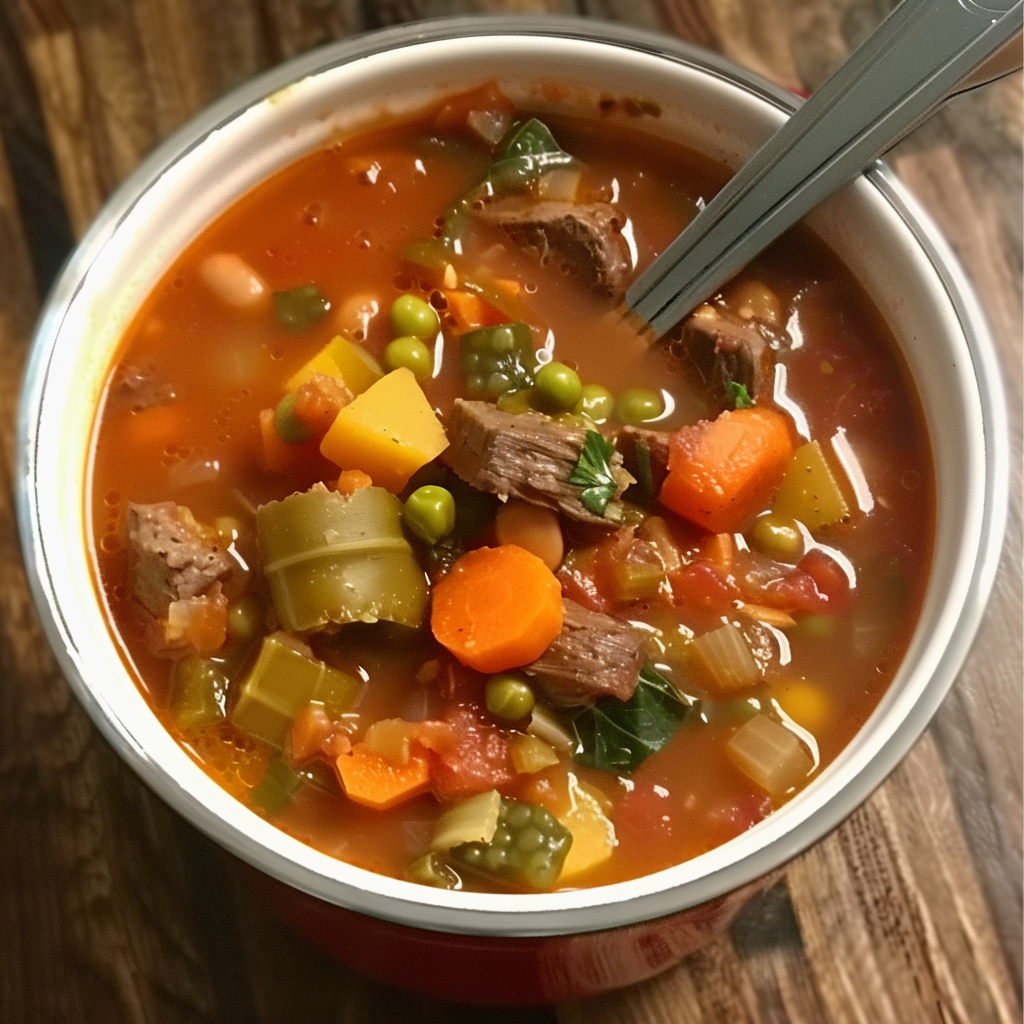
7. Nutritional Value & Health Benefits
Beyond its rich, savory flavor, vegetable beef soup is a powerhouse of nutrition. It delivers a well-balanced mix of protein, fiber, and essential vitamins—making it a wholesome addition to any meal plan.
Key Benefits
-
High Protein: Thanks to lean ground beef, each serving helps build and maintain muscle.
-
Fiber-Rich: Vegetables like carrots, celery, and green beans promote digestive health.
-
Vitamins & Minerals: Potatoes offer potassium, tomatoes provide vitamin C, and zucchini adds vitamin A.
-
Hydrating: With a broth base, this soup helps keep you hydrated.
Looking for more details on nutrient-dense ingredients? Learn about zucchini, carrots, and other soup staples through trusted sources.
For those watching sodium or calories, opt for low-sodium broth and limit added salt. Swap in olive oil for healthier fat, and skip pasta or potatoes for a lower-carb version. To learn more, explore olive oil’s benefits in cooking.
Vegetable beef soup isn’t just hearty—it’s a smart, satisfying way to support your overall wellness.
8. Popular Variations of Beef Vegetable Soup
There’s more than one way to enjoy this classic dish. Try one of these regional or method-based variations to keep things interesting while still enjoying that signature comfort food feel.
Classic with Stew Meat
-
Use beef chuck or stew meat instead of ground beef.
-
Extend the simmering time to 90 minutes for fork-tender meat.
Instant Pot Version
-
Brown beef using the sauté function.
-
Add all ingredients except quick-cook veggies.
-
Pressure cook for 20 minutes, then quick-release.
-
Stir in zucchini and green beans, and simmer on sauté for 10 more minutes.
Slow Cooker Option
-
Add browned meat, broth, and hearty vegetables to the crockpot.
-
Cook on low for 6–8 hours or high for 4 hours.
-
Add zucchini and green beans in the final hour.
Southern-Style
-
Include okra, corn, or black-eyed peas.
-
Use seasoned salt, onion powder, and smoked paprika for a Southern kick.
Italian-Inspired
-
Add pasta, Italian herbs, and a pinch of red pepper flakes.
-
Top with shredded Parmesan cheese and fresh basil.
Explore other global and regional inspirations through this Pinterest search on vegetable soup ideas and create your own flavorful twist.
9. Serving Suggestions: What to Serve with Vegetable Beef Soup
Vegetable beef soup stands strong on its own, but pairing it with the right sides can turn it into a full, satisfying meal.
Bread Options
-
Crusty sourdough
-
Garlic bread
-
Buttermilk biscuits
Salad Ideas
-
Garden salad with vinaigrette
-
Caesar salad with crunchy croutons
-
Coleslaw for a refreshing crunch
Toppings
-
Shredded cheddar or Parmesan
-
Chopped fresh parsley
-
A dollop of sour cream
Looking for presentation and side dish ideas? Check out comfort food soups on Pinterest for cozy plating inspiration.
With the right pairings, a bowl of easy beef vegetable soup becomes a well-rounded meal fit for any day of the week.
10. Make-Ahead and Meal Prep Tips
Whether you’re cooking for the week ahead or planning meals for busy evenings, vegetable beef soup is a top contender for make-ahead meals.
Meal Prep Strategy
-
Cook a double batch and divide into containers.
-
Portion into single servings for quick lunches.
-
Store family-size portions for easy weeknight dinners.
Best Containers
-
Use glass containers for fridge storage.
-
Choose freezer-safe plastic or resealable bags for long-term freezing.
-
Label with the date for easy tracking.
Meal prepping with soups like this saves time, reduces waste, and makes healthy eating effortless. Find more tips on meal prep soups that are delicious and freezer-friendly.
11. Common Mistakes to Avoid
Even a simple dish like beef vegetable soup can go wrong if you’re not careful. Here are the pitfalls to avoid for a perfect bowl every time.
-
Overcooking vegetables: Add delicate vegetables like zucchini and green beans at the end.
-
Skipping the browning step: Browning beef adds flavor—don’t rush it.
-
Adding all veggies at once: Hard vegetables like carrots and potatoes need more cooking time.
-
Under-seasoning: Taste as you go and season in layers.
-
Using high-sodium broth: Choose low-sodium or homemade broth to control salt levels.
With these tips, your soup will taste just as good on day three as it did when freshly made.
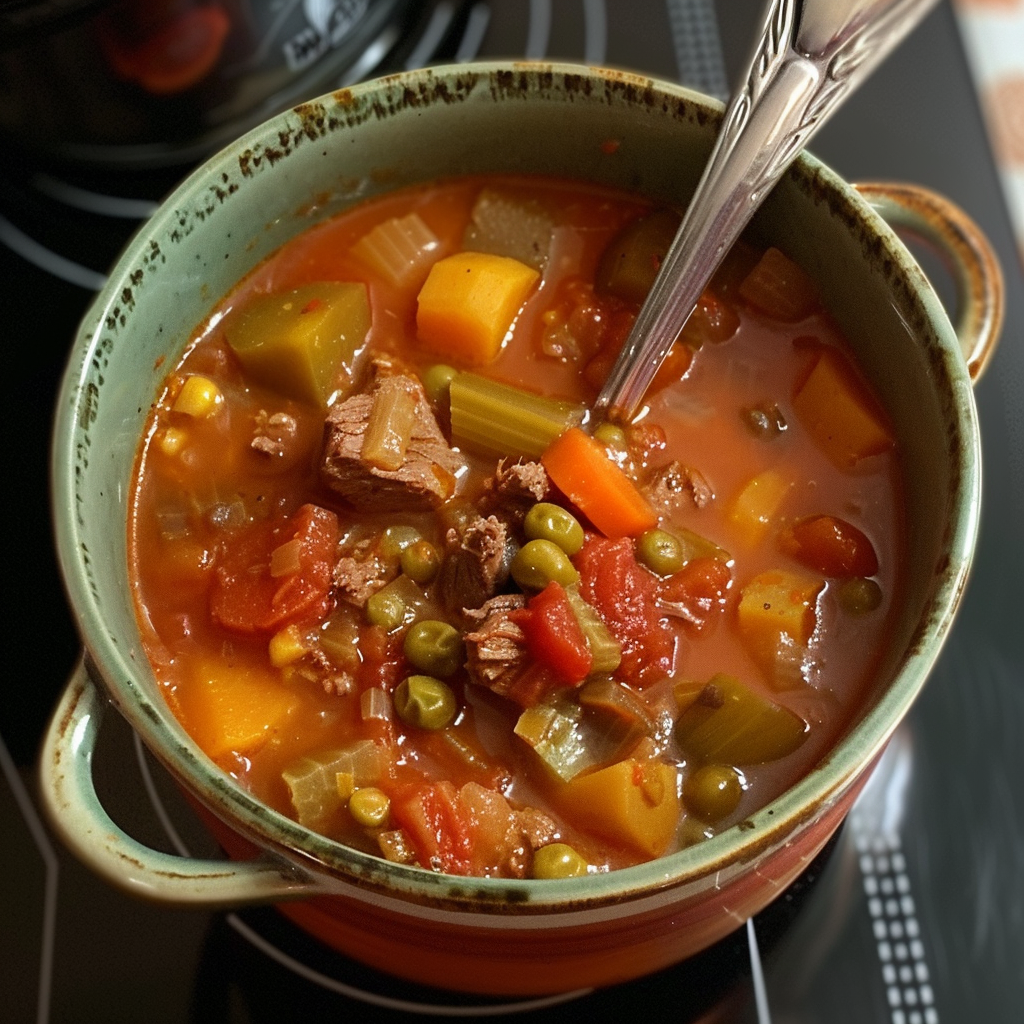
12. FAQs – People Also Ask
Can I use frozen vegetables in beef vegetable soup?
Yes, frozen vegetables work perfectly. Add them directly without thawing during the last 10–15 minutes of cooking to prevent overcooking and maintain texture.
How do I make beef vegetable soup more flavorful?
Browning the meat, sautéing onions and garlic, and using herbs like thyme and basil help deepen flavor. Add a splash of Worcestershire sauce or tomato paste for extra richness.
Can I make vegetable beef soup in a slow cooker?
Absolutely. Brown the meat first for best flavor, then combine ingredients in the slow cooker. Cook on low for 6–8 hours. Add delicate veggies like zucchini in the last hour.
Is beef vegetable soup healthy?
Yes. It’s packed with lean protein, fiber-rich veggies, and can be low in fat and sodium depending on your ingredients. It supports a balanced, whole-food diet.
What cut of beef is best for vegetable soup?
Lean ground beef is quick and easy. Stew meat or chuck roast works great for slow cooking and adds a richer texture and flavor.
How do you thicken beef vegetable soup?
Use a tablespoon of tomato paste, a cornstarch slurry, or mash a few cooked potatoes into the broth for a thicker consistency.
Can I add noodles or rice to this soup?
Yes. Cooked rice, pasta, or even barley can be stirred in before serving. Just reduce other ingredients slightly to maintain balance.
How long does homemade beef soup last in the fridge?
Stored in an airtight container, it lasts 3–4 days in the fridge. Reheat gently on the stove or microwave, adding broth if needed.
PrintEasy Vegetable Beef Soup The Essential Beef Vegetable Soup Recipe
A comforting, hearty vegetable beef soup made with lean ground beef, a medley of fresh or frozen vegetables, and savory broth. This classic soup is quick to prepare, easy to customize, and perfect for weeknight dinners, meal prep, or freezing for later.
- Author: Clara
Ingredients
- 1 lb beef stew meat, cut into bite-sized pieces
- 1 tablespoon olive oil
- 1 medium onion, chopped
- 2 cloves garlic, minced
- 3 carrots, sliced
- 3 celery stalks, sliced
- 2 potatoes, peeled and diced
- 1 zucchini, chopped
- 1 cup green beans, trimmed and cut
- 1 can (14.5 oz) diced tomatoes, undrained
- 4 cups beef broth
- 1 teaspoon dried thyme
- 1 teaspoon dried basil
- Salt and pepper to taste
Instructions
Heat olive oil in a large pot over medium-high heat. Add beef and cook until browned on all sides. Remove and set aside.
In the same pot, sauté onion and garlic until softened.
Add carrots, celery, and potatoes. Cook for 5 minutes, stirring occasionally.
Return the beef to the pot. Add diced tomatoes, beef broth, thyme, basil, salt, and pepper. Stir to combine.
Bring the mixture to a boil, then reduce heat and let simmer for about 45 minutes, or until the beef and vegetables are tender.
Add zucchini and green beans. Simmer for another 10-15 minutes, or until all vegetables are cooked through.
Taste and adjust seasoning if needed. Serve hot.
Notes
-
For deeper flavor, brown your beef thoroughly before adding other ingredients.
-
Add zucchini and green beans at the end to keep their color and texture.
-
Use low-sodium broth and lean beef for a lighter, healthier option.
-
Easily adaptable: switch proteins, add grains, or go low-carb.
-
Freezes well for up to 3 months—perfect for batch cooking.
